Unit 5 What were you doing when the rainstorm came? 单元教学设计(共6课时) 2023-2024学年人教版八年级英语下册
文档属性
| 名称 | Unit 5 What were you doing when the rainstorm came? 单元教学设计(共6课时) 2023-2024学年人教版八年级英语下册 | 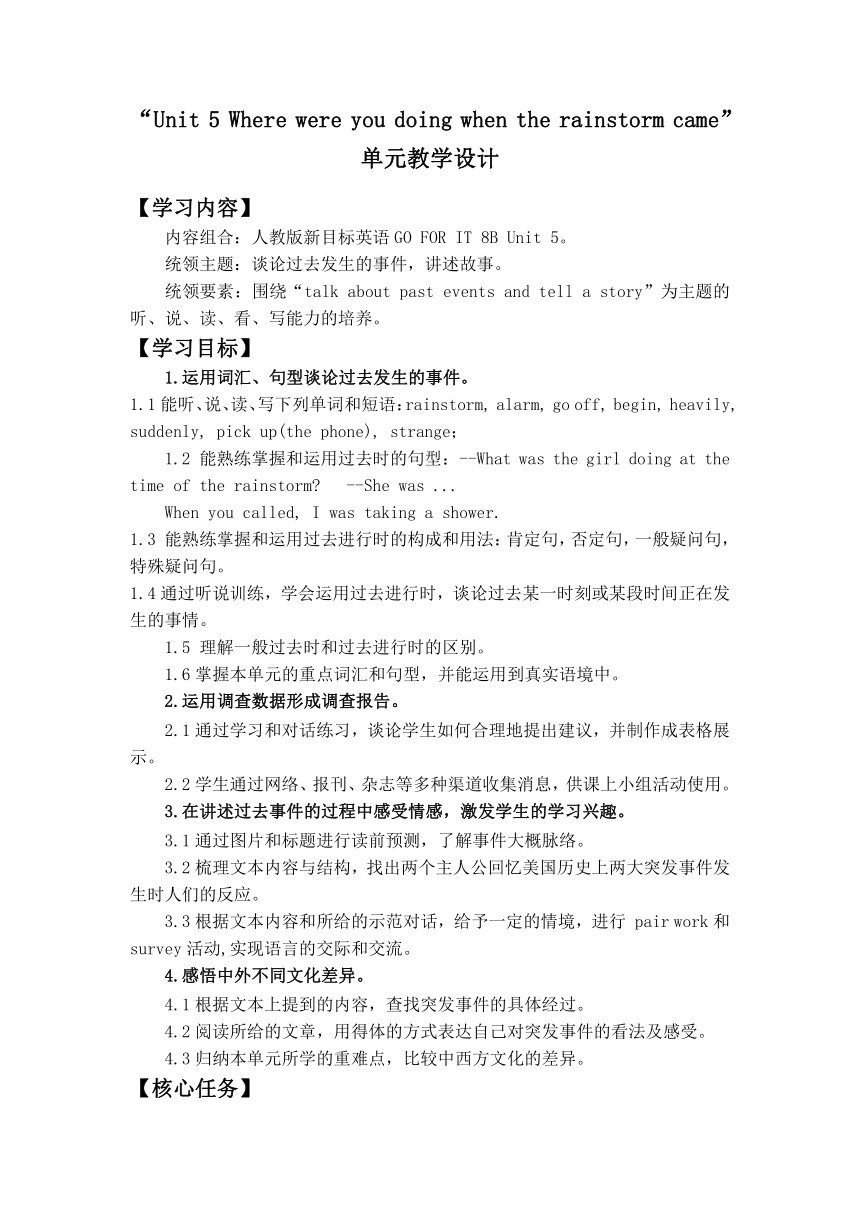 | |
| 格式 | docx | ||
| 文件大小 | 34.6KB | ||
| 资源类型 | 教案 | ||
| 版本资源 | 人教新目标(Go for it)版 | ||
| 科目 | 英语 | ||
| 更新时间 | 2024-01-29 15:26:04 | ||
图片预览

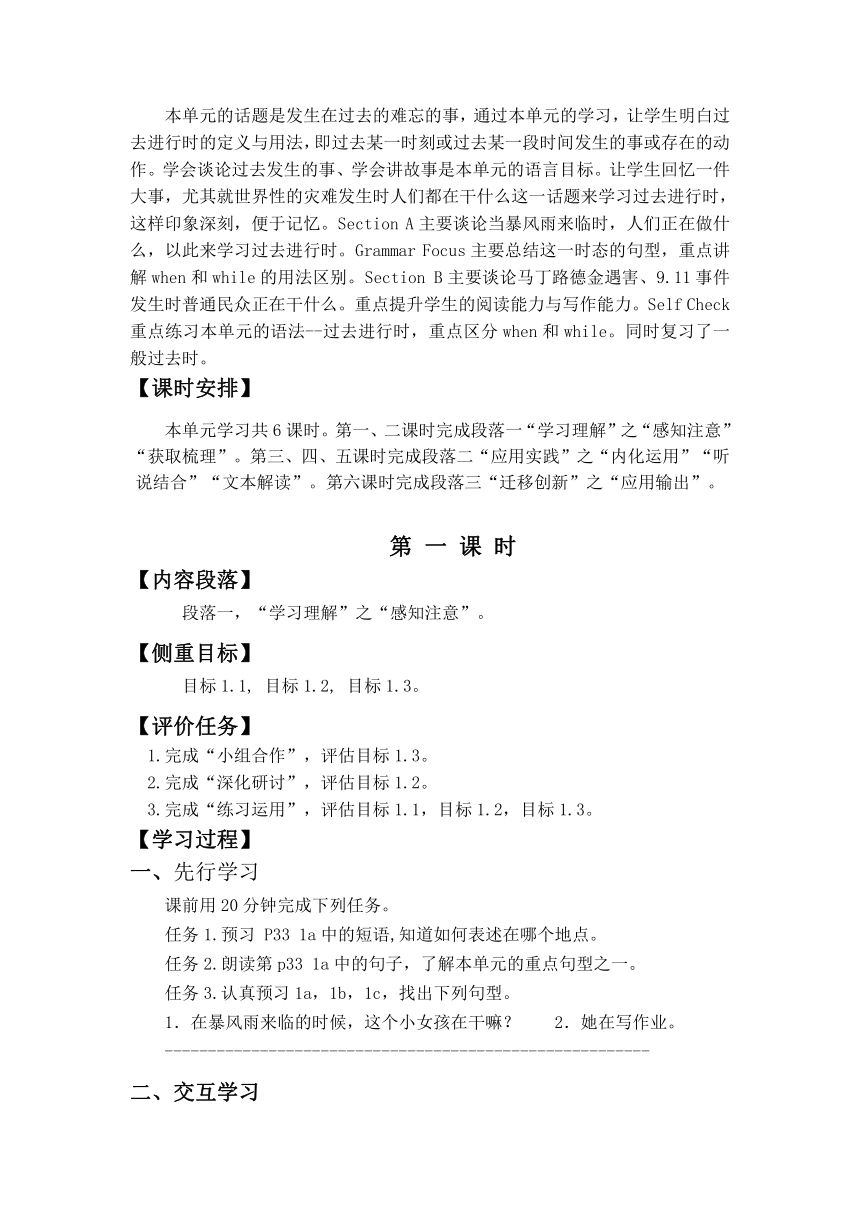
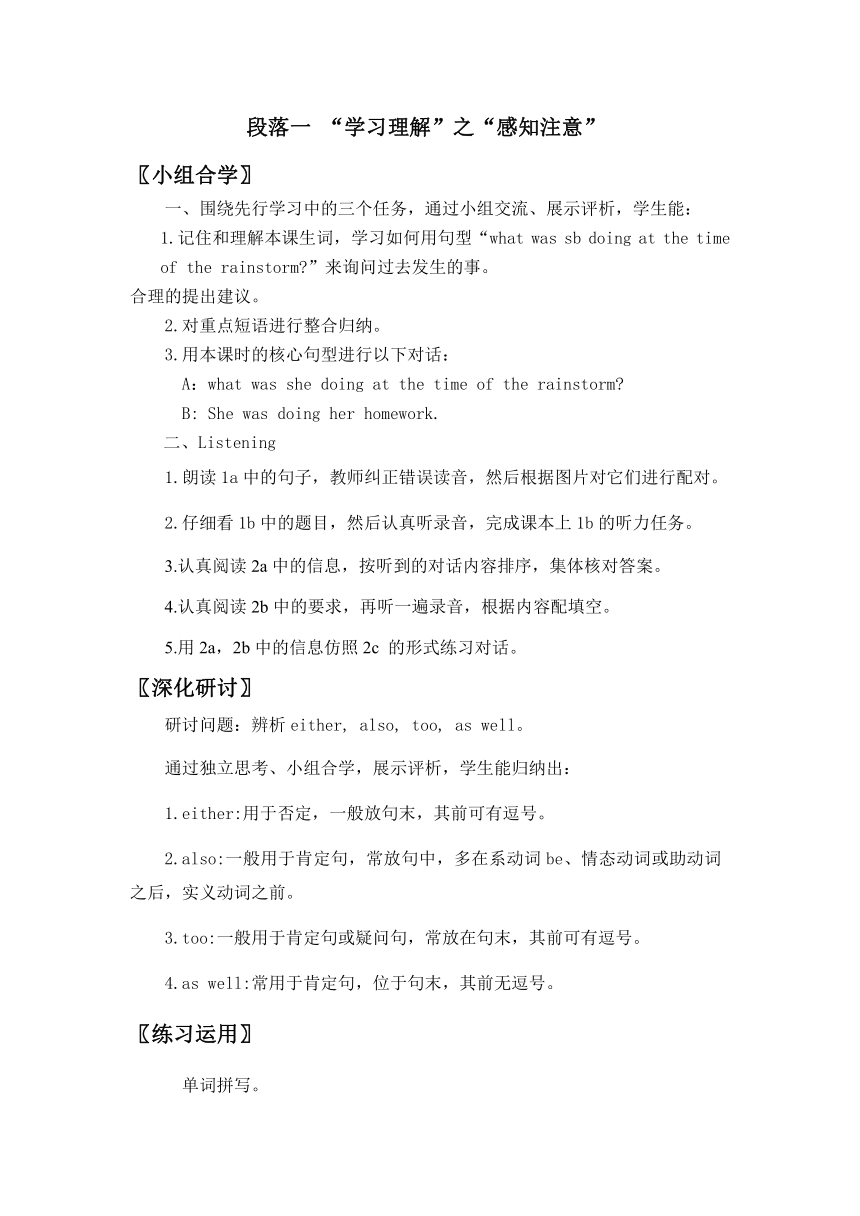
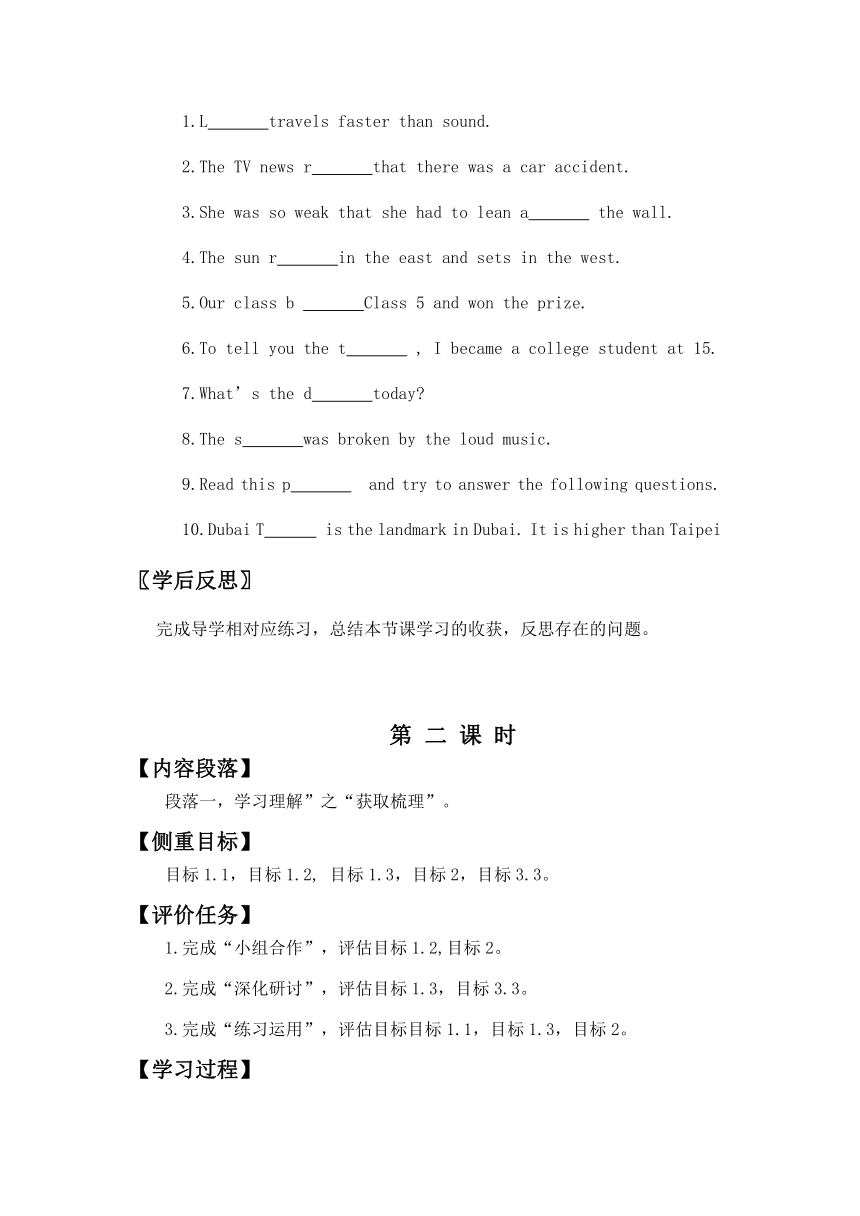
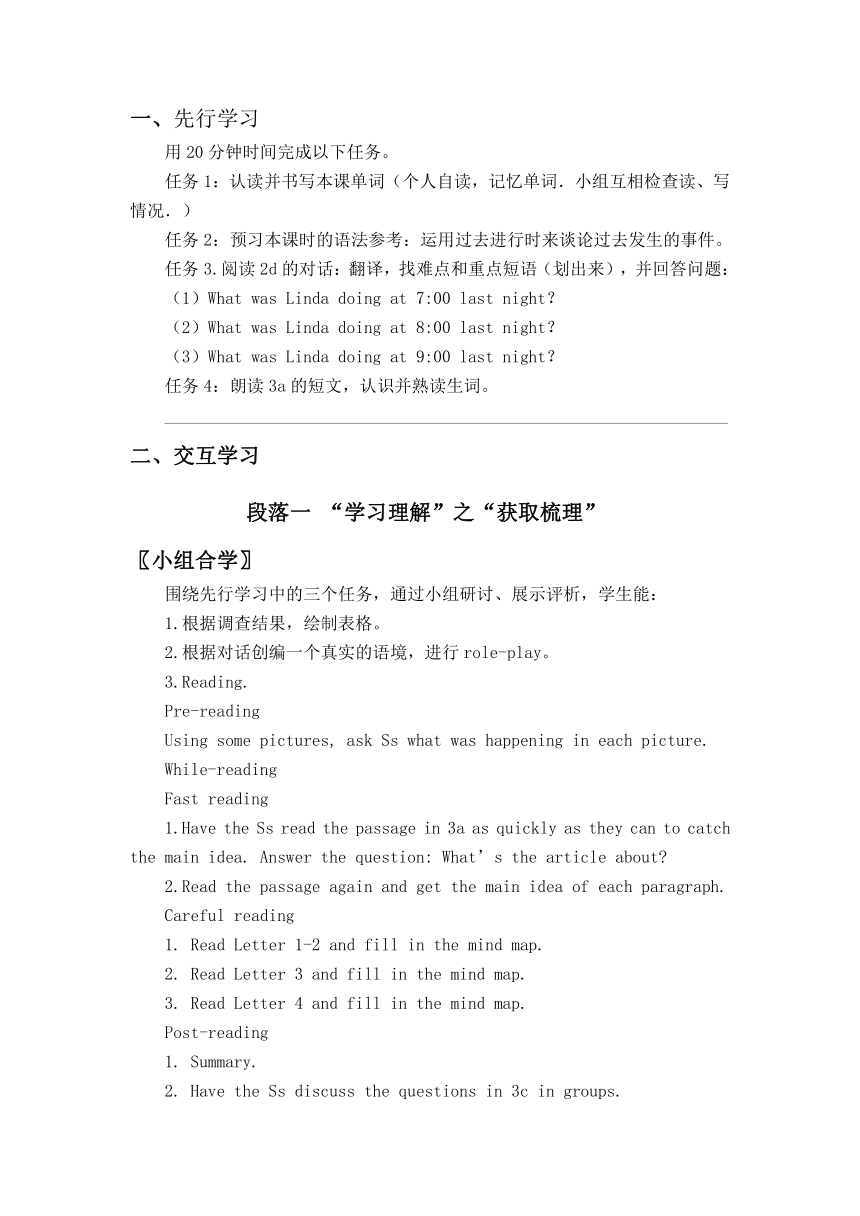
文档简介
“Unit 5 Where were you doing when the rainstorm came”单元教学设计
【学习内容】
内容组合:人教版新目标英语GO FOR IT 8B Unit 5。
统领主题:谈论过去发生的事件,讲述故事。
统领要素:围绕“talk about past events and tell a story”为主题的听、说、读、看、写能力的培养。
【学习目标】
1.运用词汇、句型谈论过去发生的事件。
1.1能听、说、读、写下列单词和短语:rainstorm, alarm, go off, begin, heavily, suddenly, pick up(the phone), strange;
1.2 能熟练掌握和运用过去时的句型:--What was the girl doing at the time of the rainstorm --She was ...
When you called, I was taking a shower.
1.3 能熟练掌握和运用过去进行时的构成和用法:肯定句,否定句,一般疑问句,特殊疑问句。
1.4通过听说训练,学会运用过去进行时,谈论过去某一时刻或某段时间正在发生的事情。
1.5 理解一般过去时和过去进行时的区别。
1.6掌握本单元的重点词汇和句型,并能运用到真实语境中。
2.运用调查数据形成调查报告。
2.1通过学习和对话练习,谈论学生如何合理地提出建议,并制作成表格展示。
2.2学生通过网络、报刊、杂志等多种渠道收集消息,供课上小组活动使用。
3.在讲述过去事件的过程中感受情感,激发学生的学习兴趣。
3.1通过图片和标题进行读前预测,了解事件大概脉络。
3.2梳理文本内容与结构,找出两个主人公回忆美国历史上两大突发事件发生时人们的反应。
3.3根据文本内容和所给的示范对话,给予一定的情境,进行 pair work和 survey活动,实现语言的交际和交流。
4.感悟中外不同文化差异。
4.1根据文本上提到的内容,查找突发事件的具体经过。
4.2阅读所给的文章,用得体的方式表达自己对突发事件的看法及感受。
4.3归纳本单元所学的重难点,比较中西方文化的差异。
【核心任务】
本单元的话题是发生在过去的难忘的事,通过本单元的学习,让学生明白过去进行时的定义与用法,即过去某一时刻或过去某一段时间发生的事或存在的动作。学会谈论过去发生的事、学会讲故事是本单元的语言目标。让学生回忆一件大事,尤其就世界性的灾难发生时人们都在干什么这一话题来学习过去进行时,这样印象深刻,便于记忆。Section A主要谈论当暴风雨来临时,人们正在做什么,以此来学习过去进行时。Grammar Focus主要总结这一时态的句型,重点讲解when和while的用法区别。Section B主要谈论马丁路德金遇害、9.11事件发生时普通民众正在干什么。重点提升学生的阅读能力与写作能力。Self Check重点练习本单元的语法--过去进行时,重点区分when和while。同时复习了一般过去时。
【课时安排】
本单元学习共6课时。第一、二课时完成段落一“学习理解”之“感知注意”“获取梳理”。第三、四、五课时完成段落二“应用实践”之“内化运用”“听说结合”“文本解读”。第六课时完成段落三“迁移创新”之“应用输出”。
第 一 课 时
【内容段落】
段落一,“学习理解”之“感知注意”。
【侧重目标】
目标1.1, 目标1.2, 目标1.3。
【评价任务】
1.完成“小组合作”,评估目标1.3。
2.完成“深化研讨”,评估目标1.2。
3.完成“练习运用”,评估目标1.1,目标1.2,目标1.3。
【学习过程】
一、先行学习
课前用20分钟完成下列任务。
任务1.预习 P33 1a中的短语,知道如何表述在哪个地点。
任务2.朗读第p33 1a中的句子,了解本单元的重点句型之一。
任务3.认真预习1a,1b,1c,找出下列句型。
1.在暴风雨来临的时候,这个小女孩在干嘛? 2.她在写作业。
--------------------------------------------------------
二、交互学习
段落一 “学习理解”之“感知注意”
〖小组合学〗
一、围绕先行学习中的三个任务,通过小组交流、展示评析,学生能:
1.记住和理解本课生词,学习如何用句型“what was sb doing at the time of the rainstorm ”来询问过去发生的事。
合理的提出建议。
2.对重点短语进行整合归纳。
3.用本课时的核心句型进行以下对话:
A:what was she doing at the time of the rainstorm
B: She was doing her homework.
二、Listening
1.朗读1a中的句子,教师纠正错误读音,然后根据图片对它们进行配对。
2.仔细看1b中的题目,然后认真听录音,完成课本上1b的听力任务。
3.认真阅读2a中的信息,按听到的对话内容排序,集体核对答案。
4.认真阅读2b中的要求,再听一遍录音,根据内容配填空。
5.用2a,2b中的信息仿照2c 的形式练习对话。
〖深化研讨〗
研讨问题:辨析either, also, too, as well。
通过独立思考、小组合学,展示评析,学生能归纳出:
1.either:用于否定,一般放句末,其前可有逗号。
2.also:一般用于肯定句,常放句中,多在系动词be、情态动词或助动词之后,实义动词之前。
3.too:一般用于肯定句或疑问句,常放在句末,其前可有逗号。
4.as well:常用于肯定句,位于句末,其前无逗号。
〖练习运用〗
单词拼写。
1.L travels faster than sound.
2.The TV news r that there was a car accident.
3.She was so weak that she had to lean a the wall.
4.The sun r in the east and sets in the west.
5.Our class b Class 5 and won the prize.
6.To tell you the t , I became a college student at 15.
7.What’s the d today
8.The s was broken by the loud music.
9.Read this p and try to answer the following questions.
10.Dubai T is the landmark in Dubai. It is higher than Taipei
〖学后反思〗
完成导学相对应练习,总结本节课学习的收获,反思存在的问题。
第 二 课 时
【内容段落】
段落一,学习理解”之“获取梳理”。
【侧重目标】
目标1.1,目标1.2, 目标1.3,目标2,目标3.3。
【评价任务】
1.完成“小组合作”,评估目标1.2,目标2。
2.完成“深化研讨”,评估目标1.3,目标3.3。
3.完成“练习运用”,评估目标目标1.1,目标1.3,目标2。
【学习过程】
一、先行学习
用20分钟时间完成以下任务。
任务1:认读并书写本课单词(个人自读,记忆单词.小组互相检查读、写
情况.)
任务2:预习本课时的语法参考:运用过去进行时来谈论过去发生的事件。
任务3.阅读2d的对话:翻译,找难点和重点短语(划出来),并回答问题:
(1)What was Linda doing at 7:00 last night?
(2)What was Linda doing at 8:00 last night?
(3)What was Linda doing at 9:00 last night?
任务4:朗读3a的短文,认识并熟读生词。
_________________________________________________________________
二、交互学习
段落一 “学习理解”之“获取梳理”
〖小组合学〗
围绕先行学习中的三个任务,通过小组研讨、展示评析,学生能:
1.根据调查结果,绘制表格。
2.根据对话创编一个真实的语境,进行role-play。
3.Reading.
Pre-reading
Using some pictures, ask Ss what was happening in each picture.
While-reading
Fast reading
1.Have the Ss read the passage in 3a as quickly as they can to catch the main idea. Answer the question: What’s the article about
2.Read the passage again and get the main idea of each paragraph.
Careful reading
Read Letter 1-2 and fill in the mind map.
Read Letter 3 and fill in the mind map.
Read Letter 4 and fill in the mind map.
Post-reading
Summary.
Have the Ss discuss the questions in 3c in groups.
〖深化研讨〗
研讨问题:when 和while的辨析
通过独立思考、小组合学,学生能归纳其语法特征:
1.when 既可以表示某一点时间,也可以表示某一段时间。从句的动作既可以与主句的动作同时发生也可以先后发生。引导状语从句时,谓语动词可以是延续性的,也可以是非延续性的。
I was just reading a book when she came into my room.
2.while 只能表示一段时间,不能表示某一点时间。从句只能表示主句的动作发生在while从句所表达的时间段内。
You can’t do your homework while you are watching TV.
〖练习运用〗
单项。
1.A bomb ________ in the theater.
A.went off B. took off C. put off D.paid off
2.The chairman _____from his chair.
A. raise B. raised C. rised D. rose
3. The Lakers _____ The Rockets by a big score.
A.beat B. to win C. beated D.winning
4.The fire ______, so we put more coal on it.
A. died down B. went down C. cut down D.brought down
5.My four-year-old daughter was _____ on the sofa.
A. sleep B. asleep C. slept
〖学后反思〗
1.梳理和绘制学习本单元A部分的“talk about past events”话题思维导图。
2.完成导学作业,总结本节课的学习收获,反思学习中存在的问题。
第 三 课 时
【内容段落】
段落二,“应用实践”之“内化运用”。
【侧重目标】
目标1.2,目标1.3,目标2.2,目标3.2,目标3.3。
【评价任务】
1.完成“小组合作”,评估目标1.2,目标1.3,目标 3.2。
2.完成“深度研学”,评估目标3.3。
3.完成“练习运用”,评估目标2.2。
【学习过程】
先行学习
课前用20分钟时间独立完成以下任务。
任务1:熟读并识记本单元的重点词汇。
任务2. 阅读Grammar Focus,并找出规律。
______________________________________
任务3:继续学习本单元得重点句型结构。
二、交互学习
段落二 “应用实践”之“内化运用”
〖小组合学〗
围绕先行学习中的三个任务,通过小组合学、展示评析,学生能:
Read the sentences aloud in Grammar Focus.
2.Fill in the blanks according to Grammar Focus.
3.Practice: complete 4a.
4.complete 4b.
5.complete 4c.
6.summary.
〖深化研讨〗
研讨问题:过去进行时态的构成与用法。
通过独立思考、小组合学,学生能归纳其语法特征:
1.肯定句
S+was/were +doing+过去的时间状语或时间状语从句
2.否定句
S+was/were +not+doing+过去的时间状语或时间状语从句
3.一般疑问句
Was/were+ S+doing+过去的时间状语或时间状语从句
4.特殊疑问句:
特殊疑问词+ was/were+ S+doing+过去的时间状语或时间状语从句
〖练习运用〗
单选。
6.This morning I ____some new restaurants on the Internet for I wanted to take Mia to a nice restaurant for her birthday.
A. picked up B. looked up C. cleaned up D.gave up
7.All I had to do was to follow him in ____.
A. Silent B. silence C . silently
8.- What’s the ______today - It’s August 8th
A. date B. day C. A&B
9.I don’t believe the _____of the story.
A. reality B. real C. truth D.true
10.Does he ______his mistake
A.recognize B. realize C. learn
〖学后反思〗
完成导学作业,总结本节课的学习收获,反思学习中存在的问题。
第 四 课 时
【内容段落】
段落二,“应用实践”之“听说结合”。
【侧重目标】
目标1,目标2。
【评价任务】
1.完成“小组合作”,评估目标1.6, 目标2.2。
2.完成“练习运用”,评估目标2.1,目标2.2。
【学习过程】
一、先行学习
课前用20分钟时间独立完成以下任务:
任务1:参照预习单上的图片,认知单词及短语。
任务2:思考:是否有没参与的重大事件,为什么没参与?
二、交互学习
段落二 “应用实践”之“深入文本”
〖小组合学〗
围绕先行学习中的四个任务,通过小组合学、展示评析,学生能:
1.教师领读词组,强调个别单词的读音,学生快速记忆词组并且两人一组互相提问。
2.认真思考1a的问题,根据情况讲述原因。
3.听录音,回答问题。
4.再听录音,标序。
5.两人一组,根据听力材料,讲述Kate所遇到的情况,角色扮演对话,完成ld。
〖练习运用〗
单项。
1.It is good manners for an Arab ______close to his friends when they are talking.
A.stand B.stands C.to stand D.standing
2.---Hi,Bruce. Here is a letter for you. ---Thanks. I wonder_____.
A. who the letter was from B.who was from the letter
C.who was the letter from D.who from the letter was
3.----Did you____the first place of the league match
----Of course we did. We_______all the other teams.
A.beat,beat B.beat,won C.win,won D.win,beat
4.The river______two inches this morning.
A.rose B.raised C.are getting up D.grow
5.--Is it______that he missed the bus
--No,he didn’t tell the______.He was late because he got up late.
A.true,truth B.real,truth C.true,reality D.real,reality
〖学后反思〗
完成导学作业,总结本节课的学习收获,反思学习中存在的问题。
第 五 课 时
【内容段落】
段落二,“应用实践”之“文本解读”。
【侧重目标】
目标3.1,目标4。
【评价任务】
1.完成“小组合学”评估目标3.1,目标4。
2.完成“练习运用”评估目标4。
【学习过程】
一、先行学习
课前用20分钟时间独立完成以下任务:
任务1:个人自读,记忆本课单词,读后小组互相检查单词阅读情况;
任务2:阅读2b短文,以小组为单位,共同找出本课中的重点内容,然后在组内交流探讨。
任务3:翻译。
这一天,马丁路德金遇害了。
绝大多数美国人都记得纽约世贸组织被恐怖分子摧毁时他们在做什么。
3.她记得当时正在距两座塔楼不远的办公室工作。
4.这一天凯特永远都不会忘记。
任务4:Read and draw a mind-map about the context of the passage.
________________________________________________________________
交互学习
段落二 “应用实践”之“文本解读”
〖小组合学〗
围绕先行学习1-4任务,通过小组合学,展示评析,学生能:
1.掌握本单元的重点词汇。
2.能正确运用本单元的句型和表达句式,并能应用到实际情境中去。
Pre-reading
Show a picture of Martin Luther King and ask the question.
While-reading
Fast reading
Let Ss read and ask the following questions.
What is the passage about
How many events are there in the passage
How many paragraphs are there in the passage
Careful reading
read Para.1 and fill in the blanks.
read Para.2 and draw the mind map.
read Para.3 and answer the questions.
read Para.4 and fill in the blanks.
Post-reading
ask Ss to retell the article.
Further-thinking: what other important events do you know Tell one to your partner.
〖练习运用〗
单项选择。
1.What ___ you ___when she came in
A.did do B. are doing C. do do D.were doing
2.Where was David ____ Linda was looking for him
A.that B.while C. at D.where
3._____TV at that time
A.Did you watched B.Have you watched
C. Were you watching D.Are you watching
4.A girl ___my pen fall off the table when she ____me.
A.saw, passed B.was seeing, passed
C. is seeing, passed D. was seeing, was passing
5.My mother was cooking while I _____music.
A.listened to B.have listened to
C. was listening to D.is listening to
〖学后反思〗
通过自我评价,量化思考,学生能找出存在问题,调整学习策略。
第 六 课 时
【内容段落】
段落三,“迁移创新”之“应用输出”。
【侧重目标】
目标3.1,目标4。
【评价任务】
1.完成“小组合学”评估目标3.1,目标4。
2.完成“练习运用”评估目标4。
【学习过程】
一、先行学习
课前用20分钟时间独立完成以下任务:
任务1:复习本单元重点词汇或短语。
任务2:运用相应的句式,谈论过去发生的事件,并能组织语言讲故事。
交互学习
段落三 “迁移创新”之“应用输出”
〖小组合学〗
围绕先行学习两个任务,通过小组合学,展示评析,学生能:
灵活应用重点词汇。
能合理地向别人讲述故事。
Pre-writing
Deal with activity 3a.
While-writing
Activity 3b. write a short article about the important event in 3a.
Next write about what you and some of your friends were doing when this event happened.
Then, write about why this event was important.
Post-writing
1.Let some Ss read their letters and correct them.
2.Give the possible version and check it.
〖练习运用〗
Self check 1, 2.
三、后续学习
1.进行第五单元的检测。
【学习内容】
内容组合:人教版新目标英语GO FOR IT 8B Unit 5。
统领主题:谈论过去发生的事件,讲述故事。
统领要素:围绕“talk about past events and tell a story”为主题的听、说、读、看、写能力的培养。
【学习目标】
1.运用词汇、句型谈论过去发生的事件。
1.1能听、说、读、写下列单词和短语:rainstorm, alarm, go off, begin, heavily, suddenly, pick up(the phone), strange;
1.2 能熟练掌握和运用过去时的句型:--What was the girl doing at the time of the rainstorm --She was ...
When you called, I was taking a shower.
1.3 能熟练掌握和运用过去进行时的构成和用法:肯定句,否定句,一般疑问句,特殊疑问句。
1.4通过听说训练,学会运用过去进行时,谈论过去某一时刻或某段时间正在发生的事情。
1.5 理解一般过去时和过去进行时的区别。
1.6掌握本单元的重点词汇和句型,并能运用到真实语境中。
2.运用调查数据形成调查报告。
2.1通过学习和对话练习,谈论学生如何合理地提出建议,并制作成表格展示。
2.2学生通过网络、报刊、杂志等多种渠道收集消息,供课上小组活动使用。
3.在讲述过去事件的过程中感受情感,激发学生的学习兴趣。
3.1通过图片和标题进行读前预测,了解事件大概脉络。
3.2梳理文本内容与结构,找出两个主人公回忆美国历史上两大突发事件发生时人们的反应。
3.3根据文本内容和所给的示范对话,给予一定的情境,进行 pair work和 survey活动,实现语言的交际和交流。
4.感悟中外不同文化差异。
4.1根据文本上提到的内容,查找突发事件的具体经过。
4.2阅读所给的文章,用得体的方式表达自己对突发事件的看法及感受。
4.3归纳本单元所学的重难点,比较中西方文化的差异。
【核心任务】
本单元的话题是发生在过去的难忘的事,通过本单元的学习,让学生明白过去进行时的定义与用法,即过去某一时刻或过去某一段时间发生的事或存在的动作。学会谈论过去发生的事、学会讲故事是本单元的语言目标。让学生回忆一件大事,尤其就世界性的灾难发生时人们都在干什么这一话题来学习过去进行时,这样印象深刻,便于记忆。Section A主要谈论当暴风雨来临时,人们正在做什么,以此来学习过去进行时。Grammar Focus主要总结这一时态的句型,重点讲解when和while的用法区别。Section B主要谈论马丁路德金遇害、9.11事件发生时普通民众正在干什么。重点提升学生的阅读能力与写作能力。Self Check重点练习本单元的语法--过去进行时,重点区分when和while。同时复习了一般过去时。
【课时安排】
本单元学习共6课时。第一、二课时完成段落一“学习理解”之“感知注意”“获取梳理”。第三、四、五课时完成段落二“应用实践”之“内化运用”“听说结合”“文本解读”。第六课时完成段落三“迁移创新”之“应用输出”。
第 一 课 时
【内容段落】
段落一,“学习理解”之“感知注意”。
【侧重目标】
目标1.1, 目标1.2, 目标1.3。
【评价任务】
1.完成“小组合作”,评估目标1.3。
2.完成“深化研讨”,评估目标1.2。
3.完成“练习运用”,评估目标1.1,目标1.2,目标1.3。
【学习过程】
一、先行学习
课前用20分钟完成下列任务。
任务1.预习 P33 1a中的短语,知道如何表述在哪个地点。
任务2.朗读第p33 1a中的句子,了解本单元的重点句型之一。
任务3.认真预习1a,1b,1c,找出下列句型。
1.在暴风雨来临的时候,这个小女孩在干嘛? 2.她在写作业。
--------------------------------------------------------
二、交互学习
段落一 “学习理解”之“感知注意”
〖小组合学〗
一、围绕先行学习中的三个任务,通过小组交流、展示评析,学生能:
1.记住和理解本课生词,学习如何用句型“what was sb doing at the time of the rainstorm ”来询问过去发生的事。
合理的提出建议。
2.对重点短语进行整合归纳。
3.用本课时的核心句型进行以下对话:
A:what was she doing at the time of the rainstorm
B: She was doing her homework.
二、Listening
1.朗读1a中的句子,教师纠正错误读音,然后根据图片对它们进行配对。
2.仔细看1b中的题目,然后认真听录音,完成课本上1b的听力任务。
3.认真阅读2a中的信息,按听到的对话内容排序,集体核对答案。
4.认真阅读2b中的要求,再听一遍录音,根据内容配填空。
5.用2a,2b中的信息仿照2c 的形式练习对话。
〖深化研讨〗
研讨问题:辨析either, also, too, as well。
通过独立思考、小组合学,展示评析,学生能归纳出:
1.either:用于否定,一般放句末,其前可有逗号。
2.also:一般用于肯定句,常放句中,多在系动词be、情态动词或助动词之后,实义动词之前。
3.too:一般用于肯定句或疑问句,常放在句末,其前可有逗号。
4.as well:常用于肯定句,位于句末,其前无逗号。
〖练习运用〗
单词拼写。
1.L travels faster than sound.
2.The TV news r that there was a car accident.
3.She was so weak that she had to lean a the wall.
4.The sun r in the east and sets in the west.
5.Our class b Class 5 and won the prize.
6.To tell you the t , I became a college student at 15.
7.What’s the d today
8.The s was broken by the loud music.
9.Read this p and try to answer the following questions.
10.Dubai T is the landmark in Dubai. It is higher than Taipei
〖学后反思〗
完成导学相对应练习,总结本节课学习的收获,反思存在的问题。
第 二 课 时
【内容段落】
段落一,学习理解”之“获取梳理”。
【侧重目标】
目标1.1,目标1.2, 目标1.3,目标2,目标3.3。
【评价任务】
1.完成“小组合作”,评估目标1.2,目标2。
2.完成“深化研讨”,评估目标1.3,目标3.3。
3.完成“练习运用”,评估目标目标1.1,目标1.3,目标2。
【学习过程】
一、先行学习
用20分钟时间完成以下任务。
任务1:认读并书写本课单词(个人自读,记忆单词.小组互相检查读、写
情况.)
任务2:预习本课时的语法参考:运用过去进行时来谈论过去发生的事件。
任务3.阅读2d的对话:翻译,找难点和重点短语(划出来),并回答问题:
(1)What was Linda doing at 7:00 last night?
(2)What was Linda doing at 8:00 last night?
(3)What was Linda doing at 9:00 last night?
任务4:朗读3a的短文,认识并熟读生词。
_________________________________________________________________
二、交互学习
段落一 “学习理解”之“获取梳理”
〖小组合学〗
围绕先行学习中的三个任务,通过小组研讨、展示评析,学生能:
1.根据调查结果,绘制表格。
2.根据对话创编一个真实的语境,进行role-play。
3.Reading.
Pre-reading
Using some pictures, ask Ss what was happening in each picture.
While-reading
Fast reading
1.Have the Ss read the passage in 3a as quickly as they can to catch the main idea. Answer the question: What’s the article about
2.Read the passage again and get the main idea of each paragraph.
Careful reading
Read Letter 1-2 and fill in the mind map.
Read Letter 3 and fill in the mind map.
Read Letter 4 and fill in the mind map.
Post-reading
Summary.
Have the Ss discuss the questions in 3c in groups.
〖深化研讨〗
研讨问题:when 和while的辨析
通过独立思考、小组合学,学生能归纳其语法特征:
1.when 既可以表示某一点时间,也可以表示某一段时间。从句的动作既可以与主句的动作同时发生也可以先后发生。引导状语从句时,谓语动词可以是延续性的,也可以是非延续性的。
I was just reading a book when she came into my room.
2.while 只能表示一段时间,不能表示某一点时间。从句只能表示主句的动作发生在while从句所表达的时间段内。
You can’t do your homework while you are watching TV.
〖练习运用〗
单项。
1.A bomb ________ in the theater.
A.went off B. took off C. put off D.paid off
2.The chairman _____from his chair.
A. raise B. raised C. rised D. rose
3. The Lakers _____ The Rockets by a big score.
A.beat B. to win C. beated D.winning
4.The fire ______, so we put more coal on it.
A. died down B. went down C. cut down D.brought down
5.My four-year-old daughter was _____ on the sofa.
A. sleep B. asleep C. slept
〖学后反思〗
1.梳理和绘制学习本单元A部分的“talk about past events”话题思维导图。
2.完成导学作业,总结本节课的学习收获,反思学习中存在的问题。
第 三 课 时
【内容段落】
段落二,“应用实践”之“内化运用”。
【侧重目标】
目标1.2,目标1.3,目标2.2,目标3.2,目标3.3。
【评价任务】
1.完成“小组合作”,评估目标1.2,目标1.3,目标 3.2。
2.完成“深度研学”,评估目标3.3。
3.完成“练习运用”,评估目标2.2。
【学习过程】
先行学习
课前用20分钟时间独立完成以下任务。
任务1:熟读并识记本单元的重点词汇。
任务2. 阅读Grammar Focus,并找出规律。
______________________________________
任务3:继续学习本单元得重点句型结构。
二、交互学习
段落二 “应用实践”之“内化运用”
〖小组合学〗
围绕先行学习中的三个任务,通过小组合学、展示评析,学生能:
Read the sentences aloud in Grammar Focus.
2.Fill in the blanks according to Grammar Focus.
3.Practice: complete 4a.
4.complete 4b.
5.complete 4c.
6.summary.
〖深化研讨〗
研讨问题:过去进行时态的构成与用法。
通过独立思考、小组合学,学生能归纳其语法特征:
1.肯定句
S+was/were +doing+过去的时间状语或时间状语从句
2.否定句
S+was/were +not+doing+过去的时间状语或时间状语从句
3.一般疑问句
Was/were+ S+doing+过去的时间状语或时间状语从句
4.特殊疑问句:
特殊疑问词+ was/were+ S+doing+过去的时间状语或时间状语从句
〖练习运用〗
单选。
6.This morning I ____some new restaurants on the Internet for I wanted to take Mia to a nice restaurant for her birthday.
A. picked up B. looked up C. cleaned up D.gave up
7.All I had to do was to follow him in ____.
A. Silent B. silence C . silently
8.- What’s the ______today - It’s August 8th
A. date B. day C. A&B
9.I don’t believe the _____of the story.
A. reality B. real C. truth D.true
10.Does he ______his mistake
A.recognize B. realize C. learn
〖学后反思〗
完成导学作业,总结本节课的学习收获,反思学习中存在的问题。
第 四 课 时
【内容段落】
段落二,“应用实践”之“听说结合”。
【侧重目标】
目标1,目标2。
【评价任务】
1.完成“小组合作”,评估目标1.6, 目标2.2。
2.完成“练习运用”,评估目标2.1,目标2.2。
【学习过程】
一、先行学习
课前用20分钟时间独立完成以下任务:
任务1:参照预习单上的图片,认知单词及短语。
任务2:思考:是否有没参与的重大事件,为什么没参与?
二、交互学习
段落二 “应用实践”之“深入文本”
〖小组合学〗
围绕先行学习中的四个任务,通过小组合学、展示评析,学生能:
1.教师领读词组,强调个别单词的读音,学生快速记忆词组并且两人一组互相提问。
2.认真思考1a的问题,根据情况讲述原因。
3.听录音,回答问题。
4.再听录音,标序。
5.两人一组,根据听力材料,讲述Kate所遇到的情况,角色扮演对话,完成ld。
〖练习运用〗
单项。
1.It is good manners for an Arab ______close to his friends when they are talking.
A.stand B.stands C.to stand D.standing
2.---Hi,Bruce. Here is a letter for you. ---Thanks. I wonder_____.
A. who the letter was from B.who was from the letter
C.who was the letter from D.who from the letter was
3.----Did you____the first place of the league match
----Of course we did. We_______all the other teams.
A.beat,beat B.beat,won C.win,won D.win,beat
4.The river______two inches this morning.
A.rose B.raised C.are getting up D.grow
5.--Is it______that he missed the bus
--No,he didn’t tell the______.He was late because he got up late.
A.true,truth B.real,truth C.true,reality D.real,reality
〖学后反思〗
完成导学作业,总结本节课的学习收获,反思学习中存在的问题。
第 五 课 时
【内容段落】
段落二,“应用实践”之“文本解读”。
【侧重目标】
目标3.1,目标4。
【评价任务】
1.完成“小组合学”评估目标3.1,目标4。
2.完成“练习运用”评估目标4。
【学习过程】
一、先行学习
课前用20分钟时间独立完成以下任务:
任务1:个人自读,记忆本课单词,读后小组互相检查单词阅读情况;
任务2:阅读2b短文,以小组为单位,共同找出本课中的重点内容,然后在组内交流探讨。
任务3:翻译。
这一天,马丁路德金遇害了。
绝大多数美国人都记得纽约世贸组织被恐怖分子摧毁时他们在做什么。
3.她记得当时正在距两座塔楼不远的办公室工作。
4.这一天凯特永远都不会忘记。
任务4:Read and draw a mind-map about the context of the passage.
________________________________________________________________
交互学习
段落二 “应用实践”之“文本解读”
〖小组合学〗
围绕先行学习1-4任务,通过小组合学,展示评析,学生能:
1.掌握本单元的重点词汇。
2.能正确运用本单元的句型和表达句式,并能应用到实际情境中去。
Pre-reading
Show a picture of Martin Luther King and ask the question.
While-reading
Fast reading
Let Ss read and ask the following questions.
What is the passage about
How many events are there in the passage
How many paragraphs are there in the passage
Careful reading
read Para.1 and fill in the blanks.
read Para.2 and draw the mind map.
read Para.3 and answer the questions.
read Para.4 and fill in the blanks.
Post-reading
ask Ss to retell the article.
Further-thinking: what other important events do you know Tell one to your partner.
〖练习运用〗
单项选择。
1.What ___ you ___when she came in
A.did do B. are doing C. do do D.were doing
2.Where was David ____ Linda was looking for him
A.that B.while C. at D.where
3._____TV at that time
A.Did you watched B.Have you watched
C. Were you watching D.Are you watching
4.A girl ___my pen fall off the table when she ____me.
A.saw, passed B.was seeing, passed
C. is seeing, passed D. was seeing, was passing
5.My mother was cooking while I _____music.
A.listened to B.have listened to
C. was listening to D.is listening to
〖学后反思〗
通过自我评价,量化思考,学生能找出存在问题,调整学习策略。
第 六 课 时
【内容段落】
段落三,“迁移创新”之“应用输出”。
【侧重目标】
目标3.1,目标4。
【评价任务】
1.完成“小组合学”评估目标3.1,目标4。
2.完成“练习运用”评估目标4。
【学习过程】
一、先行学习
课前用20分钟时间独立完成以下任务:
任务1:复习本单元重点词汇或短语。
任务2:运用相应的句式,谈论过去发生的事件,并能组织语言讲故事。
交互学习
段落三 “迁移创新”之“应用输出”
〖小组合学〗
围绕先行学习两个任务,通过小组合学,展示评析,学生能:
灵活应用重点词汇。
能合理地向别人讲述故事。
Pre-writing
Deal with activity 3a.
While-writing
Activity 3b. write a short article about the important event in 3a.
Next write about what you and some of your friends were doing when this event happened.
Then, write about why this event was important.
Post-writing
1.Let some Ss read their letters and correct them.
2.Give the possible version and check it.
〖练习运用〗
Self check 1, 2.
三、后续学习
1.进行第五单元的检测。
同课章节目录
- Unit 1 What's the matter?
- Section A
- Section B
- Unit 2 I'll help to clean up the city parks.
- Section A
- Section B
- Unit 3 Could you please clean your room?
- Section A
- Section B
- Unit 4 Why don't you talk to your parents?
- Section A
- Section B
- Unit 5 What were you doing when the rainstorm came
- Section A
- Section B
- Review of Units 1-5
- Unit 6 An old man tried to move the mountains.
- Section A
- Section B
- Unit 7 What's the highest mountain in the world?
- Section A
- Section B
- Unit 8 Have you read Treasure Island yet?
- Section A
- Section B
- Unit 9 Have you ever been to a museum?
- Section A
- Section B
- Unit 10 I've had this bike for three years.
- Section A
- Section B
